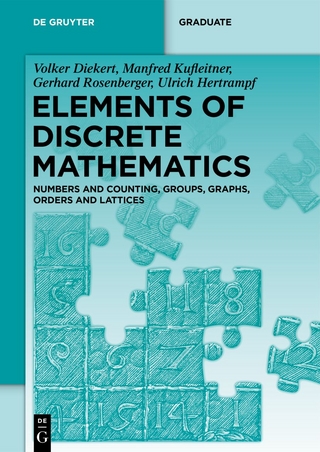
Combinatorics
Wiley-Interscience (Verlag)
978-0-471-26296-1 (ISBN)
A mathematical gem–freshly cleaned and polished This book is intended to be used as the text for a first course in combinatorics. the text has been shaped by two goals, namely, to make complex mathematics accessible to students with a wide range of abilities, interests, and motivations; and to create a pedagogical tool, useful to the broad spectrum of instructors who bring a variety of perspectives and expectations to such a course.
Features retained from the first edition:
Lively and engaging writing style
Timely and appropriate examples
Numerous well-chosen exercises
Flexible modular format
Optional sections and appendices
Highlights of Second Edition enhancements:
Smoothed and polished exposition, with a sharpened focus on key ideas
Expanded discussion of linear codes
New optional section on algorithms
Greatly expanded hints and answers section
Many new exercises and examples
RUSSELL MERRIS, PhD, is Professor of Mathematics and Computer Science at California State University, Hayward. Among his other books is Graph Theory, also published by Wiley.
Preface ix
Chapter 1 The Mathematics of Choice 1
1.1. The Fundamental Counting Principle 2
1.2. Pascal’s Triangle 10
* 1.3. Elementary Probability 21
* 1.4. Error-Correcting Codes 33
1.5. Combinatorial Identities 43
1.6. Four Ways to Choose 56
1.7. The Binomial and Multinomial Theorems 66
1.8. Partitions 76
1.9. Elementary Symmetric Functions 87
* 1.10. Combinatorial Algorithms 100
Chapter 2 The Combinatorics of Finite Functions 117
2.1. Stirling Numbers of the Second Kind 117
2.2. Bells, Balls, and Urns 128
2.3. The Principle of Inclusion and Exclusion 140
2.4. Disjoint Cycles 152
2.5. Stirling Numbers of the First Kind 161
Chapter 3 Pólya’s Theory of Enumeration 175
3.1. Function Composition 175
3.2. Permutation Groups 184
3.3. Burnside’s Lemma 194
3.4. Symmetry Groups 206
3.5. Color Patterns 218
3.6. Pólya’s Theorem 228
3.7. The Cycle Index Polynomial 241
Chapter 4 Generating Functions 253
4.1. Difference Sequences 253
4.2. Ordinary Generating Functions 268
4.3. Applications of Generating Functions 284
4.4. Exponential Generating Functions 301
4.5. Recursive Techniques 320
Chapter 5 Enumeration in Graphs 337
5.1. The Pigeonhole Principle 338
* 5.2. Edge Colorings and Ramsey Theory 347
5.3. Chromatic Polynomials 357
* 5.4. Planar Graphs 372
5.5. Matching Polynomials 383
5.6. Oriented Graphs 394
5.7. Graphic Partitions 408
Chapter 6 Codes and Designs 421
6.1. Linear Codes 422
6.2. Decoding Algorithms 432
6.3. Latin Squares 447
6.4. Balanced Incomplete Block Designs 461
Appendix A1 Symmetric Polynomials 477
Appendix A2 Sorting Algorithms 485
Appendix A3 Matrix Theory 495
Bibliography 501
Hints and Answers to Selected Odd-Numbered Exercises 503
Index of Notation 541
Index 547
| Erscheint lt. Verlag | 28.8.2003 |
|---|---|
| Reihe/Serie | Wiley Series in Discrete Mathematics and Optimization |
| Zusatzinfo | Charts: 4 B&W, 0 Color; Photos: 1 B&W, 0 Color; Drawings: 125 B&W, 0 Color; Tables: 41 B&W, 0 Color; Graphs: 16 B&W, 0 Color |
| Sprache | englisch |
| Maße | 160 x 241 mm |
| Gewicht | 930 g |
| Themenwelt | Mathematik / Informatik ► Mathematik ► Graphentheorie |
| ISBN-10 | 0-471-26296-X / 047126296X |
| ISBN-13 | 978-0-471-26296-1 / 9780471262961 |
| Zustand | Neuware |
| Haben Sie eine Frage zum Produkt? |
aus dem Bereich
